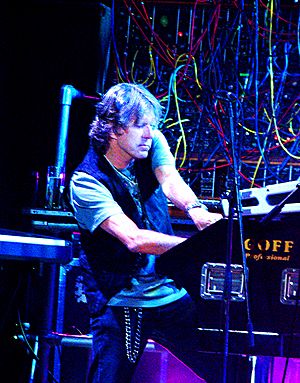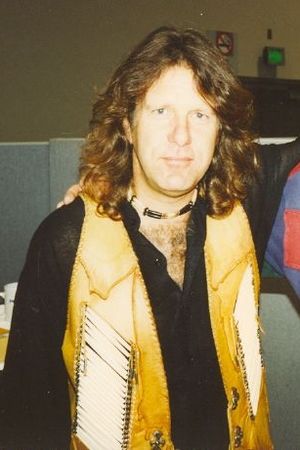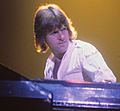Keith Emerson facts for kids
Quick facts for kids
Keith Emerson
|
|
|---|---|

Emerson performing in Saint Petersburg, Russia, September 2008
|
|
| Born |
Keith Noel Emerson
2 November 1944 Todmorden, West Riding of Yorkshire, England
|
| Died | 11 March 2016 (aged 71) Santa Monica, California, U.S.
|
| Resting place | Lancing, West Sussex, UK |
| Occupation | Musician, songwriter, composer, arranger, producer |
| Years active | 1964–2016 |
| Children | 2 |
| Musical career | |
| Genres | |
| Instruments | Keyboards, synthesizer, piano |
Keith Noel Emerson (born November 2, 1944 – died March 11, 2016) was an English musician and composer. He was known for his amazing skills on keyboard instruments. Many people think he was one of the best keyboard players in rock music history.
Contents
Who Was Keith Emerson?
Keith Emerson was a very talented musician. He played many different keyboard instruments like the piano, organ, and synthesizer. He was famous for mixing different types of music, such as rock, jazz, and classical music, into his songs.
Early Life and Music
Keith Emerson was born in Todmorden, England, in 1944. His family later moved to Goring-by-Sea. His father played the piano and taught Keith some basics. When Keith was eight, he started taking formal piano lessons. He learned to read music and play different pieces.
Discovering His Style
Even though he learned classical music, Keith was more interested in jazz piano. He listened to jazz artists like Dave Brubeck and George Shearing. He also enjoyed boogie-woogie and country-style piano music. Keith once said that he could avoid bullies at school because he could play songs by Jerry Lee Lewis and Little Richard. This made him seem "cool."
Keith became very interested in the Hammond organ after hearing a jazz organist play. He got his first Hammond organ when he was about 15 or 16. He worked at a bank for a short time, playing piano in pubs at night, but he was eventually fired. This led him to focus fully on music.
His Amazing Career
Keith Emerson played in several bands before he became famous. His first big success was with a band called the Nice in the late 1960s. With the Nice, he started making rock versions of classical music songs.
Emerson, Lake & Palmer (ELP)
In 1970, Keith left the Nice and helped form a new band called Emerson, Lake & Palmer (ELP). This band was a "supergroup" because it had very famous musicians. ELP became one of the most popular progressive rock bands in the 1970s. Progressive rock is a type of rock music that often includes long songs, complex musical parts, and influences from other music styles like classical or jazz.
Keith wrote and arranged much of ELP's music. He combined his own ideas with classical pieces, turning them into rock songs. Some of their famous albums include Tarkus (1971) and Brain Salad Surgery (1973).
Later Projects and Reunions
After ELP broke up in the late 1970s, Keith worked on his own music. He also wrote music for several movies. He formed new bands like Emerson, Lake & Powell and 3, which played music similar to ELP.
In the early 1990s, ELP got back together. They released two more albums and went on tour. Keith also reunited with the Nice for a tour in 2002. In the 2000s, he continued his solo career and toured with his own Keith Emerson Band. He even played with orchestras. In 2010, he reunited with Greg Lake for a tour and a special ELP show to celebrate the band's 40th anniversary. His last album, The Three Fates Project, came out in 2012.
How Keith Played Music
Keith Emerson was known for his unique playing style. He would sometimes reach inside his piano and hit or pluck the strings with his hand. He wanted to be creative and not just play the keys. This technique, called "string piano," was used by other composers before him.
He also mixed different musical styles in his songs. Sometimes he would switch between classical and rock music in the same song. Other times, he would play one style with one hand and a different style with the other hand! He loved modern classical music and used complex harmonies and forms like sonatas and fugues, introducing rock audiences to many classical ideas.
Instruments He Used
Keith Emerson used many different electronic keyboard instruments. He loved Hammond organs and synthesizers from companies like Moog, Yamaha, and Korg. He also played pipe organs, grand pianos, and a clavinet. When he toured with ELP, he brought a lot of equipment. For one show, he had thirteen keyboard units! He even had a very large Yamaha GX-1 synthesizer that needed eight people to move it.
Awards and Recognition
Keith Emerson received many awards for his musical talents.
- In 1980, Contemporary Keyboard magazine named him the "Overall Best Keyboardist" and "Best Multi-Keyboardist" for the fifth time in a row. This put him in their "Gallery Of The Greats."
- In 2010, he received the Frankfurt Music Prize for his achievements in music.
- In 2013, Orchestra Kentucky gave him a Lifetime Achievement Award for helping to bring classical music to a wider audience.
- In 2014, he was inducted into the Hammond Hall of Fame.
Personal Life and Hobbies
Keith Emerson married Elinor Lund in 1969. They had two sons, Aaron and Damon, before they divorced in 1994. Later, he had a long-term relationship with Mari Kawaguchi.
In 1975, his house in Sussex burned down, and he moved to London. Keith also enjoyed flying planes as a hobby and got his pilot's license in 1972.
Keith Emerson passed away on March 11, 2016, at his home in Santa Monica, California. He was 71 years old.
Images for kids
-
Emerson's grave in Lancing, West Sussex
See also
 In Spanish: Keith Emerson para niños
In Spanish: Keith Emerson para niños







